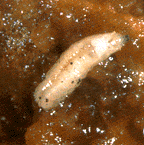Controlling Apple Maggots and Worms
 |
There are hundreds of organic apple farmers out there who would love for me to have the answer to that question. There are two main sources of apple worms, coddling moths and apple maggots. Basically, if you want to win the battle without using poisons you are going to have to get down and fight dirty. It's not going to be easy,,,,that is why dozens of organic apple growers have given up and have gone back to spraying their orchards. The one most important thing to do is to keep the orchard clear of all fallen apples, and any that are remaining on the trees. Apple maggot worms generally will develop inside fruit and emerge in the spring, while coddling moths overwinter as a larva in a cocoon under rough bark on the tree trunk near the ground. Any of these larva which happen to hatch out will, within 14 days be ready to reproduce up to 4 new generations in a year. The only way to stop this cycle, aside from chemical insecticides, is to hinder or stop the mating of the adults. You're going to have to mess with their sex lives! There are traps available at most better garden centers. They may be a yellow sticky strip, or a bright red orb resembling an apple. Either of which will be treated with a sticky attractant designed to lure the male insect. He goes looking for a lady, gets stuck, and thereby is unable to mate. These traps are primarily designed to be used as a monitor, mainly so you are able to detect the presence of the insects, and then treat the tree with chemicals as necessary. However, if you are willing to invest the time and money to buy extra traps, and check them regularly, it is theoretically possible to beat the bugs within a couple of years time. You will need a minimum of one trap per hundred apples, and you will also need to put the traps into any pear, crab-apple, Quince, hawthorn, or walnut tree, where they can also feed. While I try to avoid using them, and I think it is admirable to not use pesticides and chemicals at all, sometimes it becomes the only feasible alternative. I don't think that chemicals should ever used solely for prevention, but if there are insects, fungi, or disease already present, chemical treatment might be the best or only option. Just be certain to follow the directions to the letter!
Search The Garden Helper: